Types of Texas Shrubs (Flowering, Evergreen, Vines) With Pictures – Identification Guide
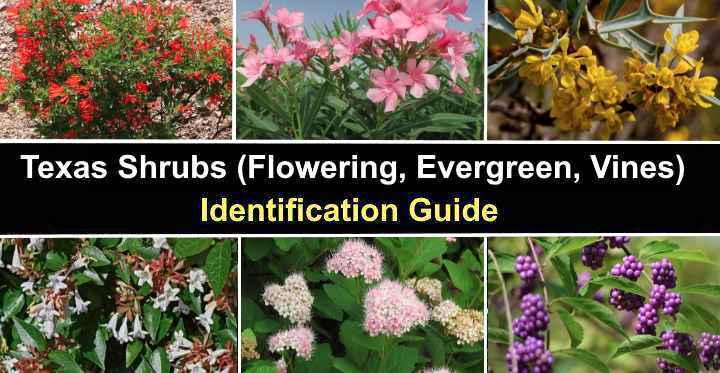
Many flowering shrubs, evergreen bushes, and trailing vines thrive in Texas garden landscapes. Native Texas shrubs perform well in full sunshine and tolerate dry, arid conditions in Central and Southern Texas. In addition, some cold-hardy flowering shrubs are perfect for growing in the Panhandle and south toward Dallas-Fort Worth, San Antonio, Midland, and Austin. Whatever the climate in Texas, there are many beautiful shrubs you can grow.
Knowing the best shrubs to plant in Texas can be challenging. Many areas of the Lone Star State are arid deserts where only some plant species can survive the heat and dusty landscape. However, northern Texas experiences cold winters where temperatures can drop below freezing.
This article is a comprehensive guide to the best flowering shrubs, evergreen shrubs, and vines for growing in Texas. Descriptions and pictures of shrubs and evergreen bushes will help you know which garden plants are best for growing in the Lone Star State.
How to Choose the Best Shrubs For Texas
When planting shrubs in a Texas landscape, it is crucial to consider your region’s USDA growing zone. Texas shrubs and vines should be cold-hardy in zones 6 through 9. Many native Texas plants can thrive in the hot summers of Central and South Texas. Still, others may not perform well in the harsh winter temperatures of North Texas.
Here is a short guide to Texas hardiness zones to help you pick suitable shrubs for planting:
USDA Zone 6: Northern Texas, where the Texas Panhandle is located. The main city is Amarillo. Average minimum temperatures are -10°F to +0°F.
USDA Zone 7: Central and Northern range south of the Red River. The main cities are Lubbock, Wichita Falls, and EL Paso. Average minimum temperatures range from 0°F to 10°F.
USDB Zone 8: Central and Eastern Texas, including cities like Dallas-Fort Worth, Austin, and Houston. Average min temps range from 10°F to 20°F.
USDB Zone 9: Southern Texas south of San Antonio to the Gulf coast. The largest cities include Laredo, Corpus Christi, and Brownsville. The average minimum temperatures range from 20°F to 30°F.
In addition to considering the hardiness zones of Texas, you should also consider sun exposure, soil type, and maintenance requirements before choosing shrubs to plant in your garden.
Types of Flowering Texas Shrubs (With Pictures) – Identification Guide
Texas has an abundance of flowering shrubs that offer beauty and fragrance throughout most of the year. Many varieties of deciduous shrubs have colorful, showy, fragrant, and exotic blooms. Here are descriptions of several types of flowering Texas shrubs for landscaping.
Texas Ranger (Leucophyllum frutescens)
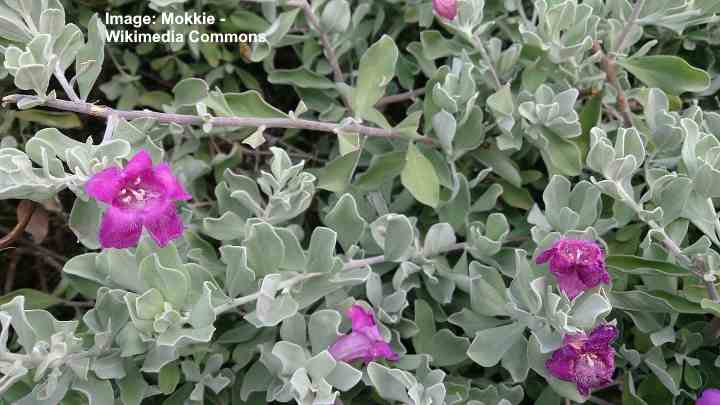
Texas Ranger (Leucophyllum frutescens)
The Texas Ranger is a flowering native shrub for Texas gardens that has small silvery-gray evergreen leaves. The evergreen low maintenance shrub has masses of pale to deep purple bell-shaped flowers. The identifying features of the native Texas Ranger shrub are its silvery leaves 1” (2.5 cm) and long purple urn-like flowers 1” (2.5 cm) across.
Also called Texas silverleaf and Texas barometer bush, the eye-catching ornamental shrub is excellent for planting in full sun as a foundation planting, hedge, evergreen flowering screen, or specimen plant. The flowering shrub thrives in all Texas zones south of Midland and Dallas.
USDA Growing Zones: 8 to 10.
Sun Exposure: Full sun.
Height and Width: 5 to 8 ft. (1.5 – 2.4 m) tall and 4 to 6 ft. (1.2 – 1.8 m) wide.
Eastern Baccharis (Baccharis halimifolia)
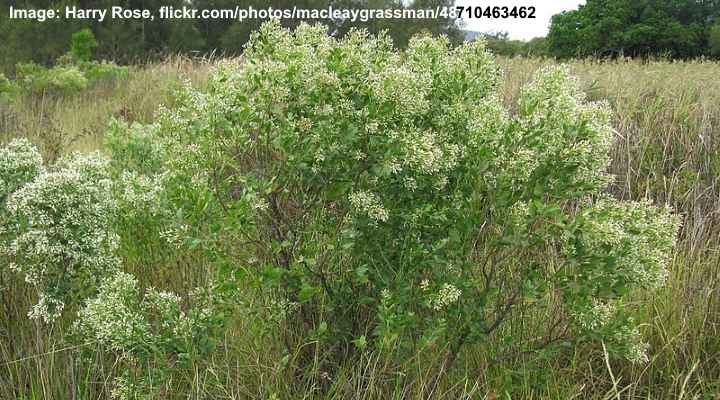
Eastern Baccharis (Baccharis halimifolia)
Prized for its showy white floral displays, eastern Baccharis is a bushy shrub native to North America. The Texas shrub’s attractive features include oval leaves with serrated margins, clusters of small, white fuzzy flowers, and an open, upright growing habit. In addition, the evergreen foliage and summer-to-fall blooms give the shrub year-long visual interest.
Eastern Baccharis is a drought-tolerant plant that is suitable for planting in full sun and in poor or dry soils. However, the fast-growing shrub also grows well in soggy ground, making it useful for planting near ponds or streams. In addition, the hardy Texas shrub is ideal for use as a hedge, desert plant, or planting in coastal gardens.
USDA Growing Zones: 5 to 11.
Sun Exposure: Full sun.
Height and Width: 3 to 10 ft. (1 – 3 m) tall and wide.
Texas Lantana (Lantana urticoides)
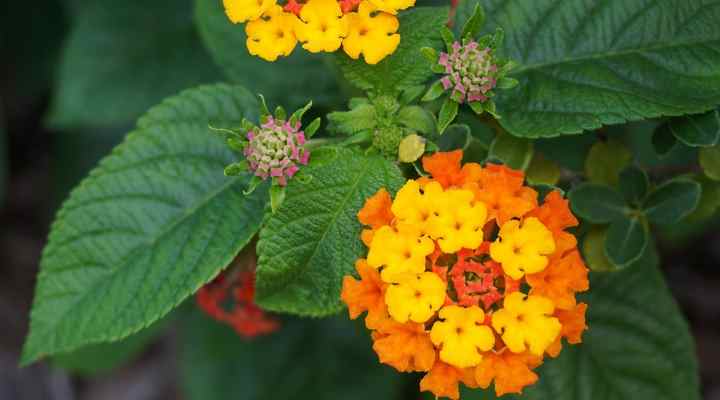
Texas Lantana (Lantana urticoides)
Texas lantana is an eye-catching heat-loving shrub for landscaping Texas gardens. The characteristics of the shrub are its brightly-colored yellow, orange, and red dome-shaped flower clusters and broadly ovate, toothed leaves forming a mound of bushy foliage followed by dark purple berries in the fall.
Texas lantana grows as a landscaping shrub throughout Texas, apart from the Panhandle, where it’s sold in nurseries as a summer bedding plant. The shrub is noted for its long-blooming season from late spring until early fall. The native full sun Texas shrub is useful for ground cover, planting in beds and borders, coastal landscapes, or native plant gardens.
USDA Growing Zones: 8 to 11.
Sun Exposure: Full sun.
Height and Width: 2 to 3 ft. (0.6 – 1 m) tall and 4 to 6 ft. (1.2 – 1.8 m) wide.
Firecracker Bush (Bouvardia ternifolia)
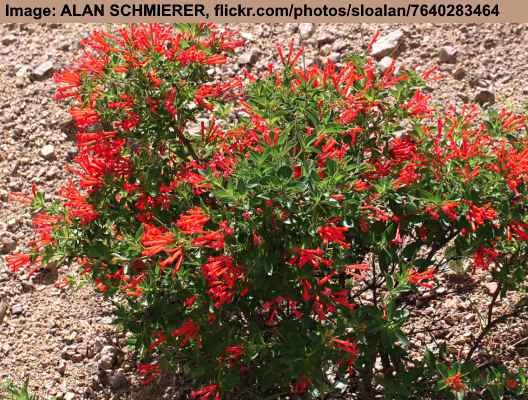
Firecracker Bush (Bouvardia ternifolia)
The spectacular red-flowering firecracker bush is a native plant to Texas desert regions. The upright, vigorous shrub has clusters of bright red tubular flowers decorating arching stems. These crimson-red native flowers cover the bush when in bloom throughout the summer. Evergreen in frost-free areas of Texas, the small mounding shrub has oval, glossy green leaves.
The firecracker bush is a low-maintenance flowering landscaping plant for Central, Northern, and Southern Texas. It looks stunning in a sunny flower bed growing in well-drained soil and getting occasional watering. You can also grow the bushy shrub in a patio container.
USDA Growing Zones: 7 to 10.
Sun Exposure: Full sun or partial shade
Height and Width: 2 to 4 ft. (0.6 – 1.2 m) tall and 2 to 3 ft. (0.6 – 1 m) wide.
Damianita (Chrysactinia mexicana)
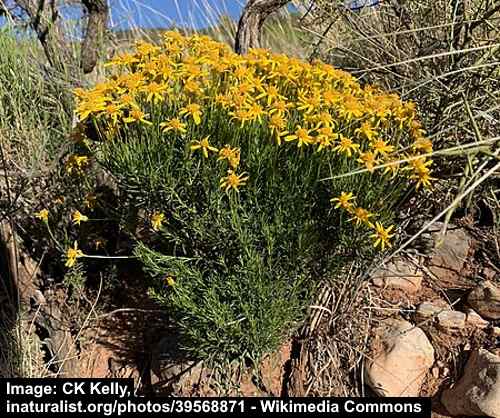
Damianita (Chrysactinia mexicana)
Damianita is a native Texas shrub known for its brightly colored star-shaped flowers, grassy aromatic foliage, and tolerance to drought. This low-growing evergreen shrub creates a mat of golden yellow when blooming from spring through fall. The plant blooms on and off, even in the hottest summer months in the Lone Star State.
Growing in full sun and dry, well-draining soils, damianita is a beautiful border plant, yellow-flowering ground cover, desert plant, or native plant for growing on slopes. The yellow daisy-like flowers measure 1” (2.5 cm) across, and the evergreen foliage keeps color in your yard throughout the year.
USDA Growing Zones: 7 to 11.
Sun Exposure: Full sun.
Height and Width: 1 to 2 ft. (0.3 – 0.6 m) tall and wide.
Oleander
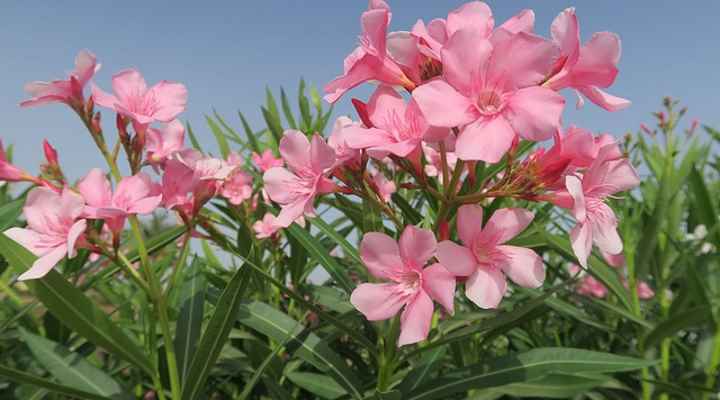
Oleander (Nerium oleander)
Oleander shrubs are a group of attractive medium-sized bushy plants with abundant clusters of pink, red, white, purple, and yellow flowers. The tough and vigorous evergreen shrub has a vase-shaped habit. It is also characterized by evergreen, lanceolate leathery leaves and showy double-bloom flowers that bloom twice a year in Southern Texas.
Native to the Mediterranean, oleander shrubs are ideal for growing in residential landscapes along the Gulf Coast and in Florida. The attractive, fragrant shrubs also thrive in full sun and well-drained soils as a vigorous flowering hedge, privacy barrier, specimen shrub, or container plant.
It’s good to remember that all parts of oleander plants are poisonous. Therefore, you should plant with care if you have children or pets in the front or backyard.
USDA Growing Zones: 8 to 11.
Sun Exposure: Full sun.
Height and Width: 2 to 3 ft. (0.6 – 1 m) tall and 4 to 6 ft. (1.2 – 1.8 m) wide.
Rosemary (Rosmarinus officinalis)

Rosemary (Rosmarinus officinalis)
Rosemary is an aromatic flowering shrub that thrives in Central and Southern Texan gardens. The attractive features of the shrub are upward-growing woody stems with small needle-like leaves, pale bluish-purple flowers, and a strongly aromatic herbal aroma. In southern states, rosemary flowers appear in summer through fall and sometimes into winter.
Ideal for a herb garden, rosemary is a wonderful shrub to create a low-growing barrier or hedge. You can also plant the fragrant, herbaceous shrub in bed and borders, along sunny walls, or add color and texture to a front-of-house planting in Texas yards.
USDA Growing Zones: 8 to 11.
Sun Exposure: Full sun.
Height and Width: 2 to 6 ft. (0.6 – 1 m) tall and 2 to 5 ft. (0.6 – 1.5 m) wide.
Japanese Spirea (Spiraea japonica)
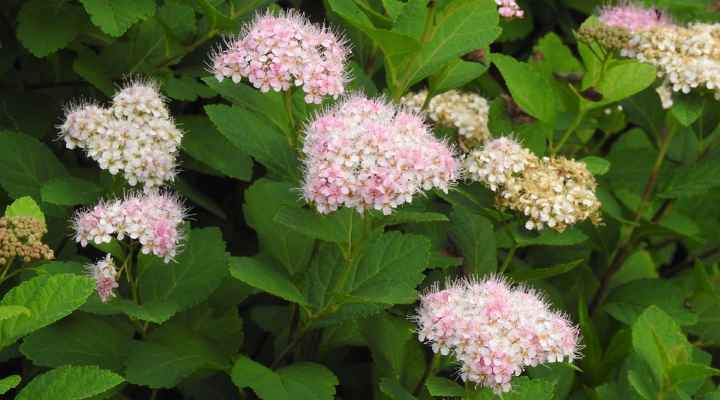
Japanese Spirea (Spiraea japonica)
Japanese spirea is an ornamental plant with domed sprays of pink or white flowers on the ends of erect stems. The flowering deciduous shrub has bright green, lance-shaped leaves. The non-native plant spreads quickly by self-seeding and can quickly form large clumps of foliage and flowers.
It’s good to note that Japanese spirea has the potential to become invasive in Texas. Therefore, if you decide to plant the ornamental shrub, look for sterile cultivars to prevent the shrub from taking over your backyard.
You can plant Japanese spirea as a foundation planting, flowering border, or on slopes and banks for soil erosion control.
USDA Growing Zones: 4 to 9.
Sun Exposure: Full sun.
Height and Width: 4 to 6 ft. (1.2 – 1.8 m) tall and 5 to 7 ft. (1.5 – 2.1 m) wide.
Crape Myrtle (Lagerstroemia)
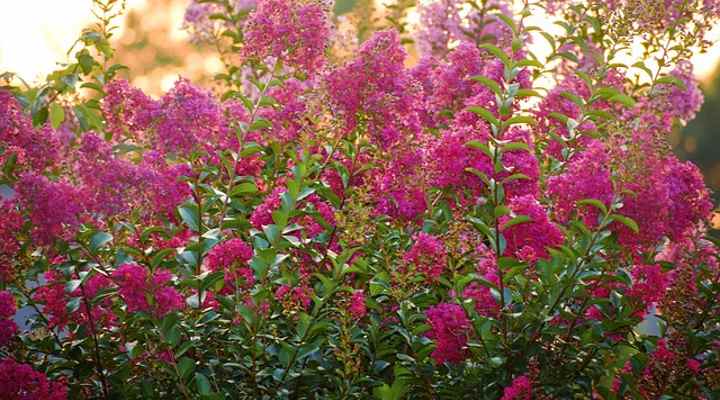
Crape Myrtle (Lagerstroemia)
Crape myrtles are compact deciduous shrubs with stunning floral and ornamental features for Texan landscapes. The multi-stemmed shrub has an upward, vase-shaped habit, and its spreading stems are covered in large clusters of crinkly flowers. The huge conical flower clusters measure 6” to 12” (15 – 30 cm) long.
Also called the lilac of the south, crape myrtle blooms in spectacular shades of pink, red, purple, and white. The long-blooming flowers persist for several months, filling Texas gardens with stunning floral displays. Then, in the fall, the foliage turns red to reddish-purple to reveal attractive exfoliating bark.
Plant crape myrtle shrubs as flowering screens or hedges, foundation plantings, or specimen plants. You can train a crape myrtle shrub to grow as a small ornamental tree with the correct pruning.
USDA Growing Zones: 8 to 11.
Sun Exposure: Full sun.
Height and Width: 2 to 3 ft. (0.6 – 1 m) tall and 4 to 6 ft. (1.2 – 1.8 m) wide.
Glossy Abelia (Abelia grandiflora)
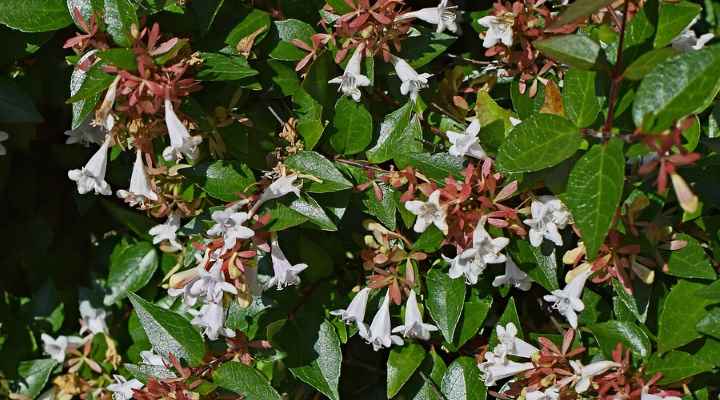
Glossy Abelia (Abelia grandiflora)
Glossy abelia is a rounded evergreen shrub that is cold hardy in Texas from Amarillo to Dallas and south to Galveston Bay. The ornamental features of this attractive plant are its dense foliage of small, oval, glossy green leaves and clusters of pinkish-white, bell-shaped fragrant flowers dangling from woody stems.
Glossy abelia is a perfect choice to decorate a Texan front or backyard. The easy-to-grow shrub thrives in full sun or partial shade and grows in well-drained soils. You can plant glossy abelia as a shrub border, informal flowering hedge, wall-side border, or foundation plant.
USDA Growing Zones: 6 to 9.
Sun Exposure: Full sun or partial shade.
Height and Width: 3 to 6 ft. (1 – 1.8 m) tall and wide.
Rose of Sharon (Hibiscus syriacus)
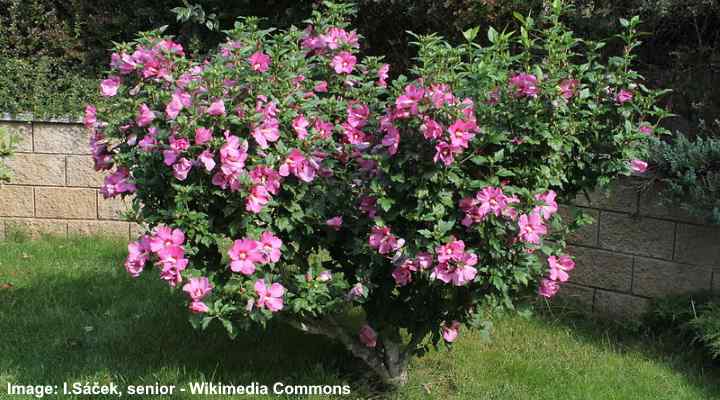
Rose of Sharon (Hibiscus syriacus)
If you want exotic flowers in a Texas landscape, then the rose of Sharon is a great choice for landscaping. The vase-shaped shrub has large, showy, funnel-shaped flowers that bloom profusely throughout summer until fall. In addition, the rose of Sharon hibiscus shrub has flowers in shades of pink, purple-blue, white, and red. These blooms contrast nicely with oak-like lobed leaves.
Rose of Sharon is cold-hardy in the north of Texas and thrives as far south as San Antonio. You can plant the drought-tolerant shrub as a summer hedgerow, shrub border, or foundation planting.
USDA Growing Zones: 5 to 8.
Sun Exposure: Full sun or partial shade.
Height and Width: 8 to 12 ft. (2.4 – 3.6 m) tall and 6 to 10 ft. (1.8 – 3 m) wide.
Related reading: Tropical hibiscus for southern landscapes.
Butterfly Bush (Buddleja)

Butterfly Bush (Buddleja)
The butterfly bush is a spectacular flowering shrub suitable for planting in all regions of the Lone Star State. The outstanding landscaping feature of the shrub is its huge conical flower spikes growing up to 15” (37 cm) long. The pink, white, or purple flower clusters bloom on arching branches from late summer until the fall.
Butterfly bush grows as a perennial shrub in northern regions of Texas when it dies back to the ground in winter. However, it’s an evergreen flowering bush in the south. Plant butterfly bushes to attract pollinators to your garden. The shrubby plant is ideal for foundation planting, cottage gardens, or shrub borders. In addition, it has long-lasting cut flowers.
USDA Growing Zones: 5 to 9.
Sun Exposure: Full sun.
Height and Width: 5 to 7 ft. (1.5 – 2.1 m) tall and wide.
Turk’s Cap (Malvaviscus arboreus var. drummondii)
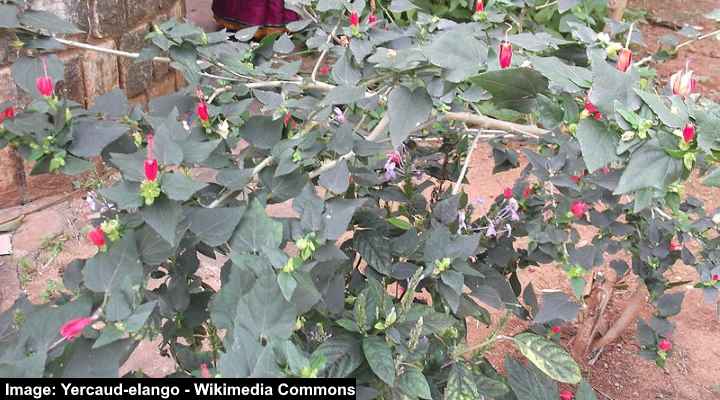
Turk’s Cap (Malvaviscus arboreus var. drummondii)
One of the best Texas shade plants is Turk’s cap. This native North American shrub blooms continuously through summer and fall with vibrant red-colored hibiscus-like flowers. The small ornamental shrub thrives in shaded gardens and tolerates drought and heat.
Also called wax mallow, Texas mallow, or Drummond’s Turk’s cap, the shrub has tube-like flowers 2” to 3” (5 – 7 cm) long, heart-shaped leaves, and plenty of ornamental appeal for shady gardens in the southern US.
USDA Growing Zones: 7 to 10.
Sun Exposure: Full shade to partial shade.
Height and Width: 2 to 5 ft. (0.6 – 1.5 m) tall and wide.
Agarita (Mahonia trifoliolata)
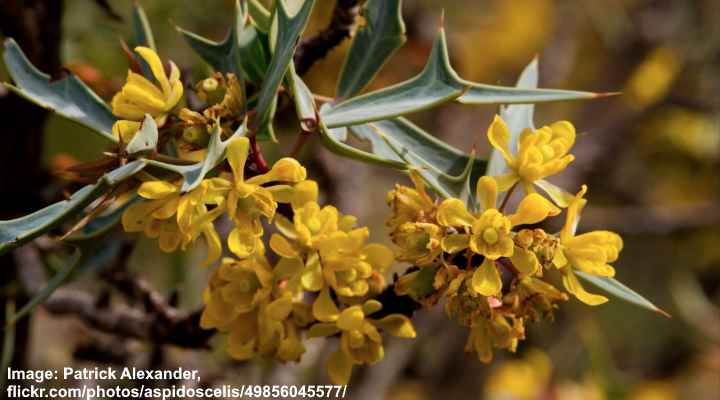
Agarita (Mahonia trifoliolata)
Also called Laredo Oregon-grape, this sun-loving evergreen shrub is identified by its clusters of yellow cup-shaped flowers, sharp-tipped stiff, gray-green leaves, and edible red berries. Agarita requires little care to thrive in a desert landscape. Unfortunately, the native Texas flowering shrub also has suckering stems that require removal to retain its ornamental value.
Agarita is a shrub that thrives in dry landscapes. You can plant it as a foundation planting or as a specimen plant.
USDA Growing Zones: 8 to 11.
Sun Exposure: Full sun.
Height and Width: 2 to 3 ft. (0.6 – 1 m) tall and 4 to 6 ft. (1.2 – 1.8 m) wide.
American Beautyberry (Callicarpa americana)
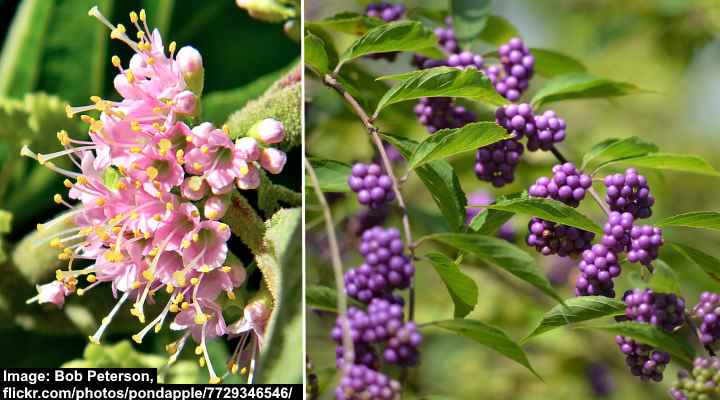
American Beautyberry (Callicarpa americana)
American beautyberry is an attractive native shrub famed for its clusters of bright violet-colored fruits. This bushy shrub has graceful arching branches that bloom with clusters of small white, purple, or pink flowers and produces elliptical leaves with a fuzzy texture. However, the showy purple berries set this shrub apart from the others.
American beautyberry thrives in full sun or partial shade. The landscaping shrub provides an abundance of vibrant colors in a Texan front or backyard. You can grow it at the back of the border or as a specimen plant.
USDA Growing Zones: 6 to 11.
Sun Exposure: Full sun or partial shade.
Height and Width: 3 to 6 ft. (1 – 1.8 m) tall and wide.
Flame Acanthus (Anisacanthus quadrifidus var. wrightii)
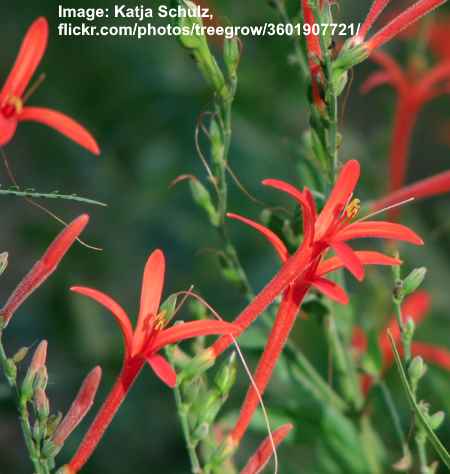
Flame Acanthus (Anisacanthus quadrifidus var. wrightii)
Also called desert honeysuckle, this native Texan shrub has eye-catching red tubular flowers reminiscent of honeysuckle flowers. The upright deciduous shrub has small lanceolate leaves growing on slender stems. It’s a heat-loving, drought-tolerant shrub suitable for growing in all regions of Texas, apart from the Panhandle.
The flame acanthus shrub is perfect for growing in beds and borders, cottage gardens, or as a flowering hedgerow. Its ornamental blooms also add a bang of red colors to perennial gardens.
USDA Growing Zones: 7 to 10.
Sun Exposure: Full sun.
Height and Width: 3 to 5 ft. (1 – 1.5 m) tall and 3 to 4 ft. (1 – 1.2 m) wide.
Rock Rose (Pavonia lasiopetala)
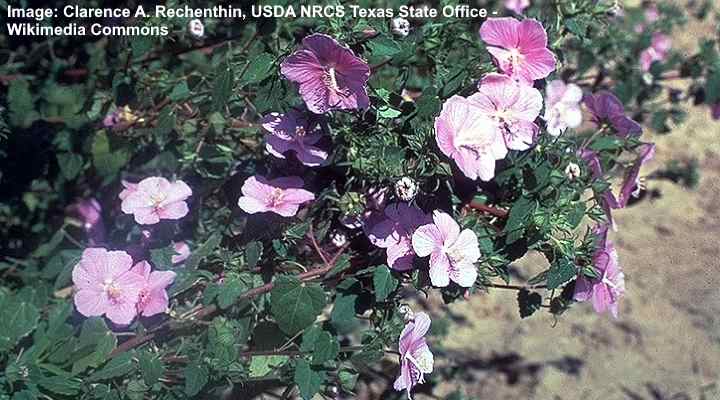
Rock Rose (Pavonia lasiopetala)
Rock rose is a small shrub that thrives in Central and Southern Texas. The ornamental features of the shrub are its showy pink flowers with five papery petals and a conspicuous yellowish stamen. In addition, this bushy, low-growing vigorous shrub has leaves with serrated edges. This landscaping shrub blooms in Texas from June through fall.
This shrubby herbaceous plant is ideal for small sunny gardens due to its compact habit. Furthermore, its spreading nature makes it an ideal choice for pink-flowering ground cover.
USDA Growing Zones: 8 and 9.
Sun Exposure: Full sun or partial shade.
Height and Width: 4 ft. (1.2 m) tall and wide.
Esperanza or Yellow Bells (Tecoma stans)
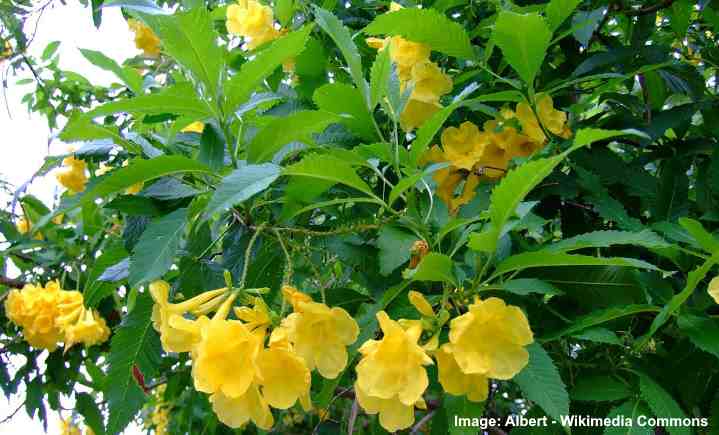
Yellow bells (Tecoma stans)
Yellow bells is an attractive ornamental bush for Southern Texas landscapes. This shrub is known for its bright golden-yellow funnel-shaped flowers and rapid growth dangling from arching stems. The rapidly-growing shrub blooms from spring until the first frost. In contrast, in Southern Texas, its spectacular yellow blossoms bloom throughout the year.
Yellow-flowering esperanza is ideal for dry arid landscapes in South Texas.
USDA Growing Zones: 9 to 11.
Sun Exposure: Full sun.
Height and Width: 10 to 25 ft. (3 – 7.5 m) tall and 10 to 20 ft. (3 – 6 m) wide.
Creeping Mahonia (Mahonia repens)
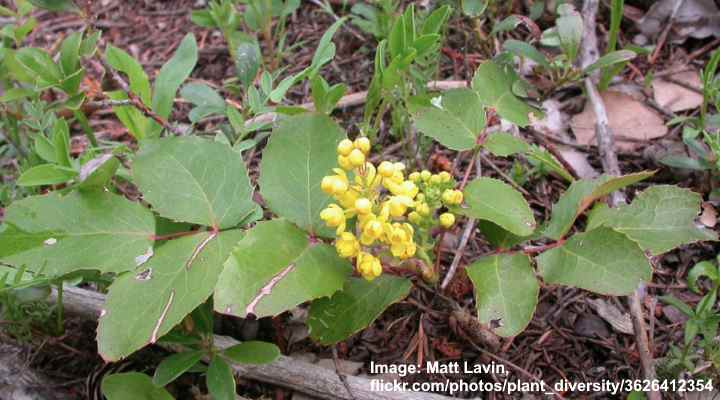
Creeping Mahonia (Mahonia repens)
Creeping mahonia is a low-growing evergreen shrub with clusters of bright yellow flowers followed by waxy blue fruits. The shrub has glossy foliage consisting of holly-like jagged leaves that are dark green and turn pinkish-red in the fall. This spreading shrub produces a blanket of green foliage and yellow flowers.
Also called creeping hollygrape or prostrate barberry, the yellow-flowering shrub is ideal for ground cover in full sun or planting on borders. Its underground roots also make it ideal for soil erosion control.
USDA Growing Zones: 5 to 8.
Sun Exposure: Full sun or part shade.
Height and Width: 1 to 2 ft. (0.3 – 0.6 m) tall and wide.
Viburnum
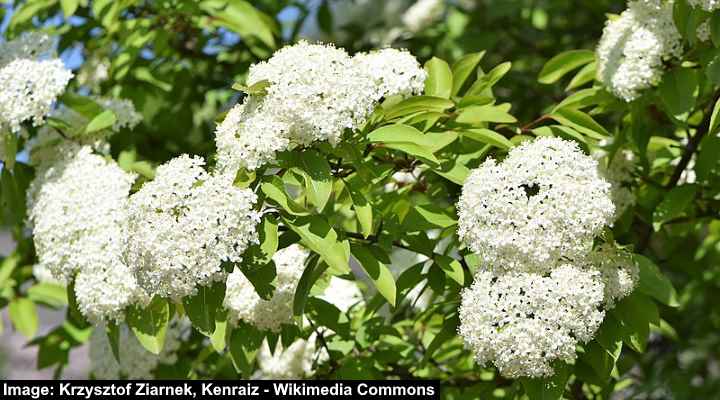
Viburnum (Viburnum prunifolium)
Viburnum is a white-flowering deciduous shrub, ideal for landscaping gardens throughout Texas. The multi-stemmed shrub produces masses of flat-topped clusters of creamy-white flowers. These contrast nicely with dense foliage before giving way to clusters of bluish-black berries in the fall. The shrub’s fall color is rich bronze to bright red.
Viburnum is a versatile cold-hardy landscaping shrub as it is tolerant of heat, drought, and clay soil. This Texas shrub is ideal for landscaping a front or backyard including shrub borders, flowering hedges, or along a foundation line.
USDA Growing Zones: 3 to 9.
Sun Exposure: Full sun or partial shade.
Height and Width: 12 to 15 ft. (3.6 – 4.5 m) tall and 6 to 12 ft. (1.8 – 2.4 m) wide.
Types of Evergreen Texas Shrubs
Texas is home to a wide variety of evergreen shrubs that can add year-round color and texture to your landscape. Let’s look in detail at some of the most popular evergreen shrubs for Texas gardens.
Heavenly Bamboo (Nandina domestica)
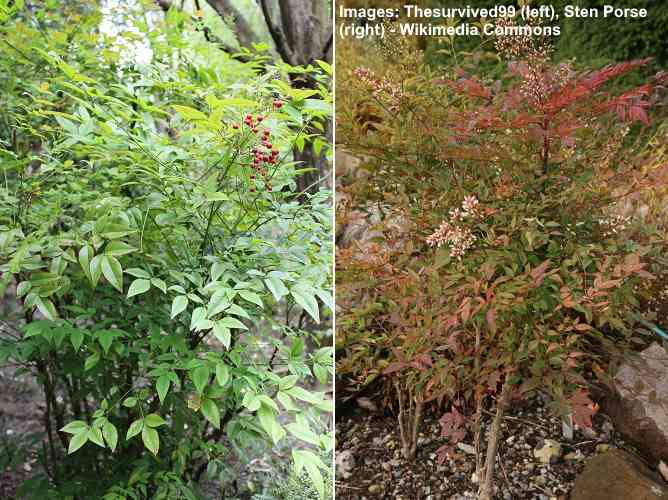
Heavenly Bamboo (Nandina domestica)
Heavenly bamboo is a shade-tolerant flowering ornamental shrub with bamboo-like stems producing attractive lance-shaped leaves. This evergreen has attractive green foliage that turns fiery red in the fall. The evergreen shrub’s flowers are clusters of tiny white flowers followed by bright red berries in the winter.
This hardy and versatile plant is a great addition to any garden in Central and Southern Texas to add a pop of color from spring until fall. Plant it as a shrub border, foundation planting, privacy screen, or specimen plant.
USDA Growing Zones: 6 to 9.
Sun Exposure: Full sun or dappled sunlight.
Height and Width: 3 to 4 ft. (1 – 1.2 m) tall and 3 to 5 ft. (1 – 1.5 m) wide.
Prickly Pear (Opuntia species)
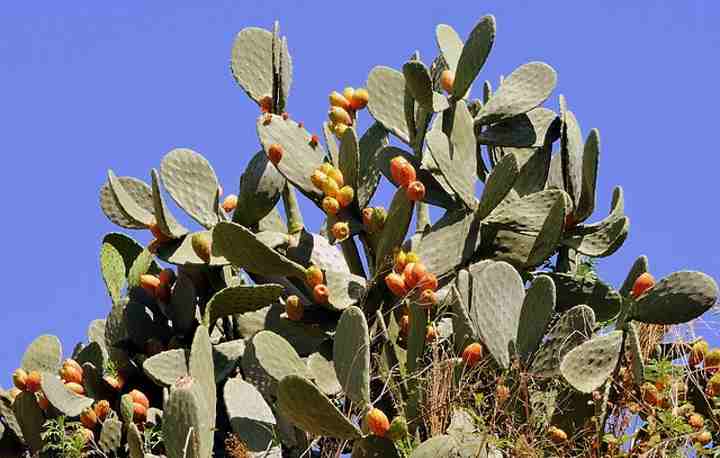
prickly pear (Opuntia)
Prickly pear is a shrubby cactus plant that produces attractive red or yellow flowers on the tips of its paddle-like stems. This desert cactus plant is easily recognizable due to its oval, flattened, fleshy stems covered in spiny thorns. After flowering, edible egg-shaped fruits appear on the plant.
The prickly pear is an iconic cactus in the Chihuahuan Desert. However, you can also plant prickly pears in a xeriscape garden, rock garden, or as a specimen plant.
USDA Growing Zones: 6 to 11.
Sun Exposure: Full sun.
Height and Width: 1 to 2 ft. (0.3 – 0.6 m) tall and wide.
Related reading: Types of desert cacti.
Texas Mountain Laurel (Sophora secundiflora)
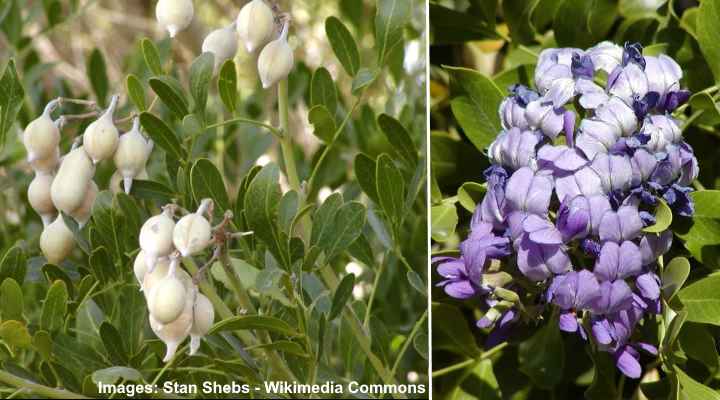
Texas Mountain Laurel (Sophora secundiflora)
Do you want to plant a purple-flowering shrub in a Texan landscape? If so, the native Texas mountain laurel is an excellent choice. The large multi-stemmed shrub has a slow growth rate and produces drooping clusters of fragrant purple-blue flowers followed by whitish-gray seed pods, contrasting with lustrous dark green leaves.
Texas mountain laurel is well-suited to the harsh, hot climates of Central and Southern Texas. It’s highly drought-tolerant and thrives in dry soils in coastal regions. Plant it as a foundation planting, shrub border, or evergreen hedge. You can also train it to grow as a purple-flowering tree to add a splash of color to your yard.
USDA Growing Zones: 7 to 10.
Sun Exposure: Full sun or partial shade.
Height and Width: 15 to 25 ft. (4.5 – 7.5 m) tall and 8 to 10 ft. (2.4 – 3 m) wide.
Littleleaf Boxwood (Buxus microphylla)

‘Winter Gem’ boxwood (Buxus microphylla ‘Winter gem’)
Littleleaf boxwood is a compact evergreen shrub, ideal for planting at the front of the house in a Texan garden. The attractive hedge plant has densely-growing lush oval leaves and retains its deep green color through hot Texas summers. It’s a tough, hardy shrub that requires little maintenance.
Littleleaf boxwood is a great evergreen option for Texas landscaping because it is more drought, humidity, and heat-tolerant than other boxwood shrubs. The shrub performs well as a formal front yard hedge, container plant, or line a driveway or path.
USDA Growing Zones: 6 to 9.
Sun Exposure: Full sun to full shade.
Height and Width: 3 to 5 ft. (1 – 1.5 m) tall and wide.
Southern Wax Myrtle (Morella cerifera)
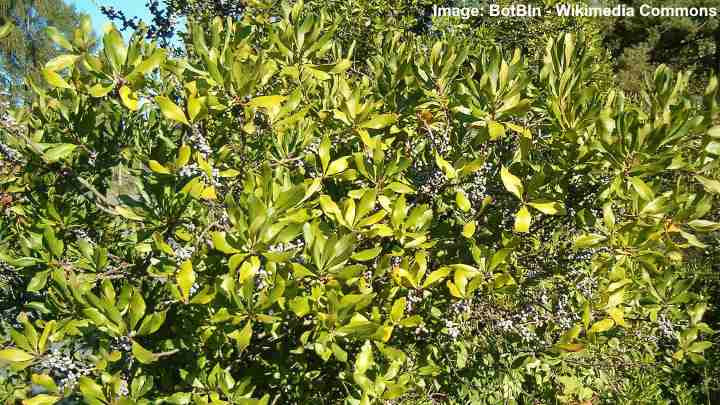
Southern Wax Myrtle (Morella cerifera)
The native Texas southern wax myrtle is an evergreen shrub with clusters of fragrant flowers followed by waxy, light blue berries. Identifying features of this wax myrtle shrub are its aromatic, lanceolate, olive-green leaves and showy berries. The versatile landscaping shrub tolerates sun and partial shade and performs well in dry or soggy soils.
Southern wax myrtle is an ideal choice for planting in frost-free coastal regions. In addition, it’s a popular shrub for growing as a hedge, shrub border, screen, or in wetland gardens.
USDA Growing Zones: 7 to 11.
Sun Exposure: Full sun or partial shade.
Height and Width: 10 to 15 ft. (3 – 4.5 m) tall and 8 to 10 ft. (2.4 – 3 m) wide.
Cherry Laurel (Prunus caroliniana)
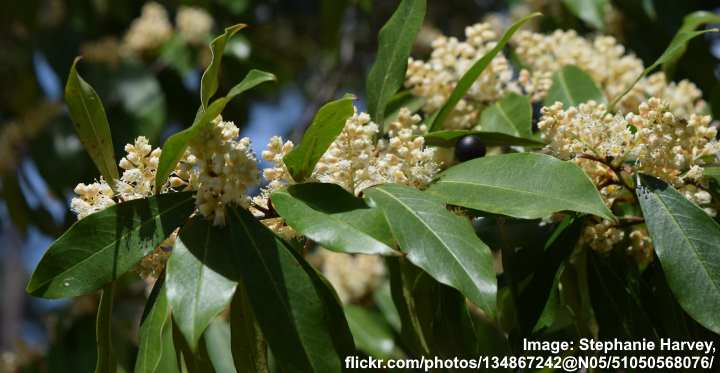
Cherry Laurel (Prunus Caroliniana)
Cherry laurel is a heat-loving evergreen shrub native to the Southern United States. The landscaping features of the fast-growing plant are its glossy, dark green leaves, tiny white fragrant flowers growing in dense clusters, and reddish purple drupes that persist through winter.
The most popular landscaping uses for cherry laurel shrub in Texas are as a hedge, windbreak, or privacy screen. The lush green foliage, white flowers, and black berries also provide four-season interest in front or backyards.
USDA Growing Zones: 7 to 10.
Sun Exposure: Full sun or part shade.
Height and Width: 20 to 30 ft. (6 – 9 m) tall and 15 to 25 ft. (4.5 – 7.5 m) wide.
Texas Sotol (Dasylirion acrotrichum)
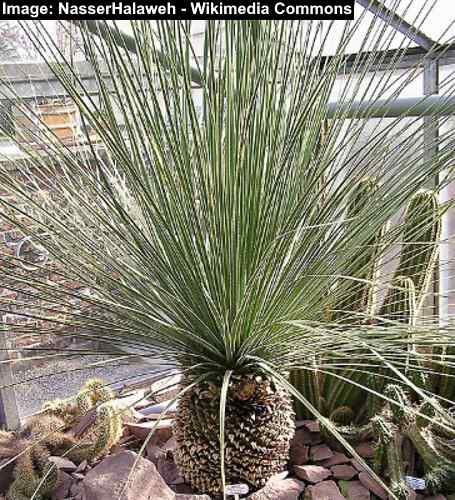
Texas Sotol (Dasylirion acrotrichum)
Also called the great desert spoon, Texas sotol is an evergreen succulent with ornamental features. The long, pointed, ribbon-like leaves grow in a round rosette with up to 300 leaves in a single plant. Small white tufts grow at the end of the 3-feet long spiky leaves.
Plant Texas sotol to make a dramatic statement in a southern garden landscape. The outdoor succulent plant thrives in a xeriscape garden, rock garden, or dry, well-drained soils.
USDA Growing Zones: 8 to 10.
Sun Exposure: Full sun.
Height and Width: 5 to 6 ft. (1.5 – 1.8 m) tall and wide.
Dwarf Bottlebrush (Callistemon viminalis ‘Little John’)

Dwarf Bottlebrush (Callistemon viminalis ‘Little John’)
Are you looking for an ornamental dwarf shrub to plant in a compact Texas landscape? If so, a dwarf bottlebrush shrub is an excellent choice. The sun-loving, heat-tolerant plant has spectacular bright red fuzzy flowers like a bottlebrush. These blooms contrast nicely with the narrow bluish-green leaves
The compact, dense shrub with its rounded habit is perfect for coastal gardens in Southern Texas. The shrubs grow as far north as El Paso, San Antonio, and Dallas. They are ideal for growing as a low hedge or foundation planting.
USDA Growing Zones: 8 to 12.
Sun Exposure: Full sun.
Height and Width: 3 ft. (1 m) tall and 5 ft. (1.5 m) wide.
Apache Plume (Fallugia paradoxa)
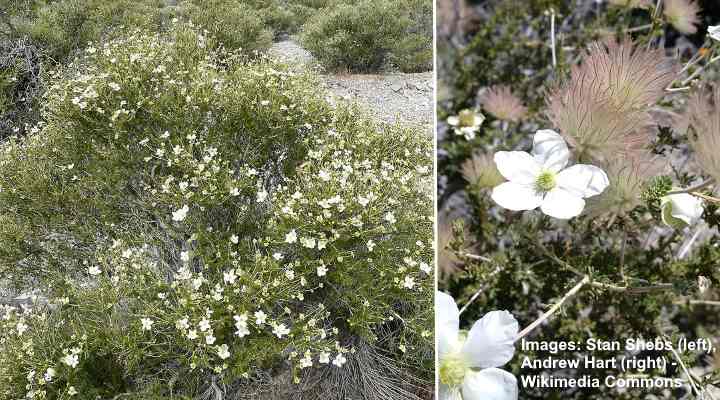
Apache Plume (Fallugia paradoxa)
Thriving in dry, scorched landscapes, Apache plume is a small, semi-evergreen shrub with clusters of five-petalled flowers. After blooming, the white flowers give way to fluffy white and pink seed heads, from where the plant gets its names as they resemble Apache headdresses.
Apache plume has great ornamental value in a xeric landscape. The mounding shrub adds texture and color and is excellent for erosion control. Plant the shrub in dry, sandy, well-drained soils.
USDA Growing Zones: 6 to 8.
Sun Exposure: Full sun.
Height and Width: 4 to 6 ft. (1.2 – 1.8 m) tall and 4 to 5 ft. (1.2 – 1.5 m) wide.
Yaupon Holly (Ilex vomitoria)
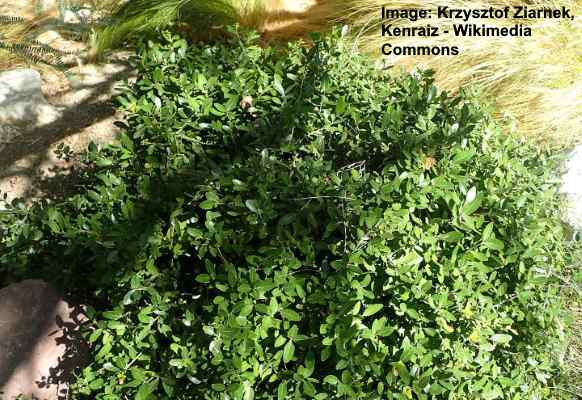
Dwarf Yaupon Holly (Ilex vomitoria ‘Nana’)
The yaupon holly is a large evergreen shrub with glossy red berries, clusters of white flowers, and lustrous dark green leaves. Thanks to its evergreen foliage and red winter berries, Yaupon holly adds a splash of color to winter landscapes throughout Texas. It’s also drought-resistant and tolerant of salt spray.
Yaupon holly has many ornamental features for landscaping a Texan garden. The dense evergreen foliage of this Texas shrub creates an excellent privacy screen, windbreak, noise barrier, or hedge.
If you want to landscape a small garden, choose the Ilex vomitoria ‘Nana’ cultivar. This small landscaping shrub only grows 3 to 5 ft. (1 – 1.5 m) tall.
USDA Growing Zones: 7 to 9.
Sun Exposure: Full sun or partial shade.
Height and Width: 10 to 20 ft. (3 – 6 m) tall and 8 to 12 ft. (2.4 – 3.6 m) wide.
Vines to Grow in Texas
Texas is home to a variety of vines that can be used to add texture, color, and interest to any garden. From evergreen vines with fragrant flowers to flowering vines that attract hummingbirds, Texas gardeners have plenty of options. Let’s look in detail at some of the best vines for growing in Texas:
Trumpet Vine (Campsis radicans)
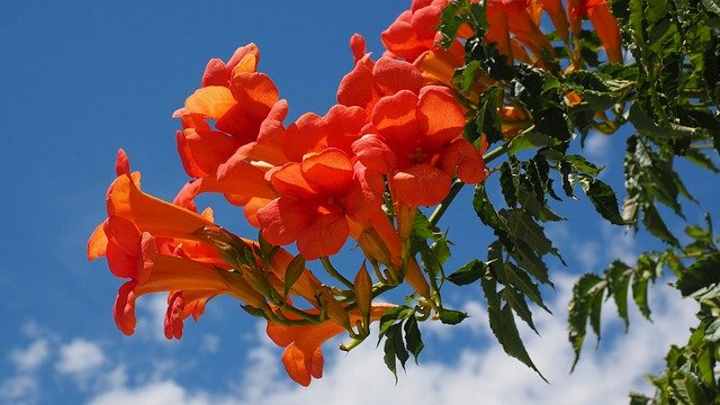
Red Trumpet Creeper Vine (Campsis radicans)
The trumpet vine is a climbing or scrambling plant with brightly-colored orange or red tubular flowers. This vigorous vining plant has masses of funnel-shaped flowers that are 3” (7.5 cm) long and bloom throughout the summer. The vine also has pinnate leaves consisting of tiny pointed leaflets.
The fast-growing spreading vine clings to most surfaces like English ivy. You can plant it to cascade over retaining walls or fences and cover arbors or trellises. It’s good to know that the vine, although native to Texas, tends to spread aggressively.
USDA Growing Zones: 5 to 9.
Sun Exposure: Full sun or partial shade.
Height and Width: 20 to 40 ft. (6 – 12 m) tall and 5 to 10 ft. (1.5 – 3 m) wide.
Crossvine (Bignonia capreolata)
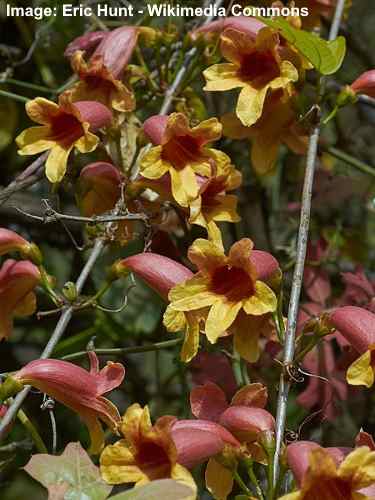
Crossvine (Bignonia capreolata)
Crossvine is a native Texas vining plant with abundant showy flowers blooming in shades of red, orange, and yellow. This scrambling and climbing plant flowers bloom in clusters of two to five trumpet-shaped blossoms. It has dark green leaves that retain their color throughout the year in frost-free climates.
This easy-to-grow vine is perfect for adding a pop of bright colors to trellises, fences, arbors, or hanging baskets. Additionally, the attractive vine is an excellent ground cover landscaping solution.
USDA Growing Zones: 6 to 9.
Sun Exposure: Full sun or partial sun.
Height and Width: 30 to 50 ft. (9 – 15 m) tall and 6 to 9 ft. (1.8 – 2.7 m) wide.
Scarlet Clematis (Clematis texensis)
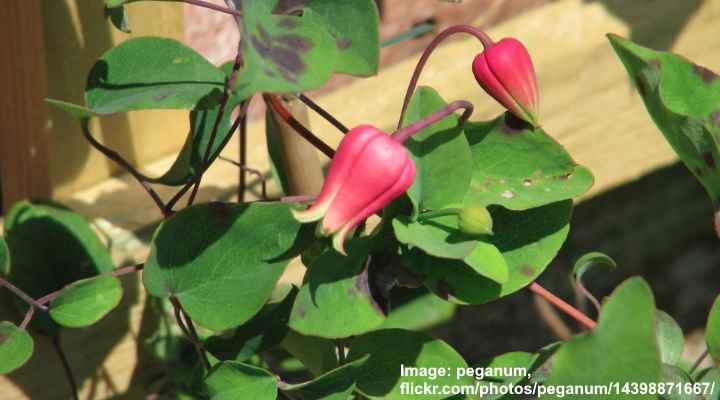
Scarlet Clematis (Clematis texensis)
Also called Texas clematis, this native red-flowering vining plant has eye-catching tulip-like flowers growing on slender stems. The deep red flowers bloom late in summer and persist through fall, contrasting with the attractive heart-shaped leaves. The attractive vining flowers have four twisted tepals creating an open cup shape.
Scarlet clematis vines thrive in full sun and add vibrant colors to Texan landscapes. The floriferous vines are perfect for scrambling over a wall, climbing an arbor, or growing as red-flowering ground cover.
USDA Growing Zones: 4 to 8.
Sun Exposure: Full sun or afternoon shade in the hottest summer months.
Height and Width: 10 to 15 ft. (3 – 4.5 m) tall and 2 to 3 ft. (0.6 – 1 m) wide.
Carolina Jessamine (Gelsemium sempervirens)
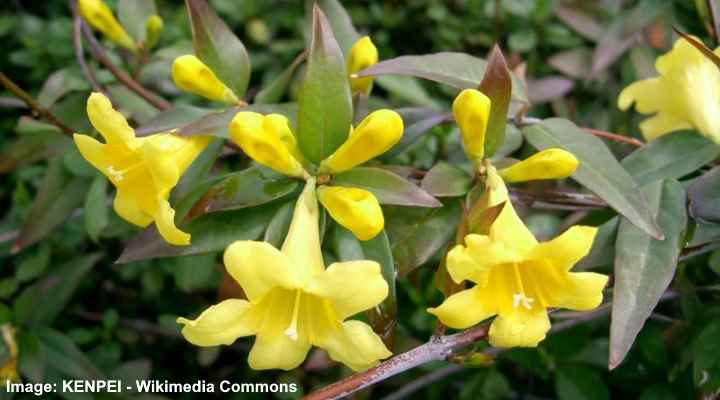
Carolina Jessamine (Gelsemium sempervirens)
This yellow-flowering climber has masses of trumpet-shaped bright yellow flowers on its climbing stems. The funnel flowers appear in late winter and early spring and persist throughout summer. These blossoms contrast nicely with the dense green foliage. The flowers measure 1.5” (3 cm) across, and the leaves are 3” (7.5 cm) long.
Landscaping ideas for Carolina jessamine for a backyard in Texas include climbing tree trunks, scrambling over fences or arbors, or using as ground cover.
USDA Growing Zones: 7 to 10.
Sun Exposure: Full sun or partial shade.
Height and Width: 10 to 20 ft. (3 – 6 m) tall and 3 to 6 ft. (1 – 1.8 m) wide.
Beach Morning Glory (Ipomoea imperati)
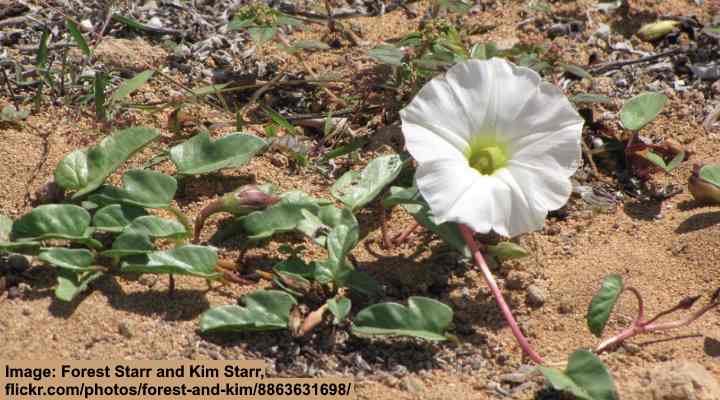
Beach Morning Glory (Ipomoea imperati)
Beach morning glory is a creeping evergreen vine recognized by its large funnel-shaped white flowers. The mat-forming, ground-hugging scrambling plant blooms profusely from summer through fall. These large pure white flowers contrast with the lush, fleshy green leaves. As the name suggests, this vining plant thrives in sandy soils.
Beach morning glory grows low to the ground but can spread far. Its tolerance to salty air, heat, and drought makes it a great choice for coastal landscaping and beachfront homes.
USDA Growing Zones: 8 to 11.
Sun Exposure: Full sun.
Height and Width: 6” (15 cm) tall and 10 to 50 ft. (3 – 15 m) wide.
White Honeysuckle (Lonicera albiflora)

White Honeysuckle (Lonicera albiflora)
White honeysuckle is a scrambling vine with creamy-white flowers and oval grayish-green leaves. Like many honeysuckles, the characteristic feature of the fragrant, showy flowers is its curling petals and prominent stamens. Blooming in late spring, this native Texas vining plant thrives in the Central and Southern regions of the state.
Vining honeysuckle is an attractive white-flowering vine for landscaping southern gardens. You can enjoy its floral displays while the plant grows over walls, fences, trellises, and arbors.
USDA Growing Zones: 7 to 10.
Sun Exposure: Full sun or partial shade.
Height and Width: 3 to 10 ft. (1 – 3 m) tall and 3 to 8 ft. (1 – 2.4 m) wide.
American Wisteria (Wisteria frutescens)
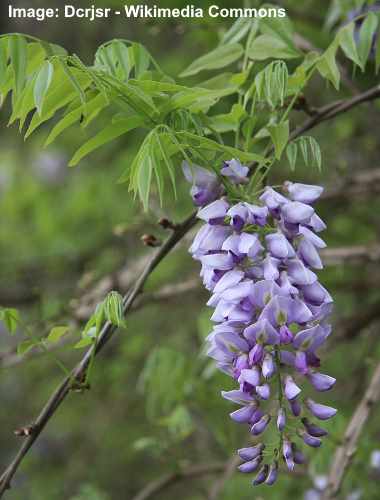
American wisteria (Wisteria frutescens)
The stunning American wisteria is a woody climbing plant with conical clusters of showy purple flowers. The masses of lilac-purple blooms droop from the stem as they appear in late spring and early summer. After the flowers finish, attractive bean-like pods appear and persist into winter. Flower clusters measure 6” (15 cm) long, and the pods are 5” (13 cm) long.
American wisteria is a vigorous vining plant that twists around poles, arbors, pergolas, and other structures. The woody vine is also ideal for growing near patios and decks to enjoy its summer flowers.
USDA Growing Zones: 5 to 9.
Sun Exposure: Full sun.
Height and Width: 15 to 30 ft. (4.5 – 9 m) tall and 4 to 8 ft. (1.2 – 2.4 m) wide.
Best Shrubs for North Texas
The best shrubs for north Texas are:
- American Beautyberry (Callicarpa americana)
- Firecracker Bush (Bouvardia ternifolia)
- Rose of Sharon (Hibiscus syriacus)
- Flame Acanthus (Anisacanthus quadrifidus var. wrightii)
- Cenizo (Leucophyllum frutescens)
Best Shrubs for Central Texas
The best shrubs for central Texas are:
- Texas Lantana (Lantana urticoides)
- Texas Mountain Laurel (Sophora secundiflora)
- Cenizo (Leucophyllum frutescens)
- Rosemary (Rosmarinus officinalis)
- White Honeysuckle (Lonicera albiflora)
Best Shrubs for West Texas
The best shrubs for west Texas are:
- Buttonbush (Cephalanthus occidentalis)
- Yaupon Holly (Ilex vomitoria)
- Trumpet Vine (Campsis radicans)
- Southern Wax Myrtle (Morella cerifera)
- Butterfly Bush (Buddleja)
Best Shrubs for South Texas
The best shrubs for south Texas are:
- Carolina Jessamine (Gelsemium sempervirens)
- Dwarf Bottlebrush (Callistemon viminalis ‘Little John’)
- Texas Mountain Laurel (Sophora secundiflora)
- Yellow Bells (Tecoma stans)
- Crape Myrtle (Lagerstroemia)
Related articles:
